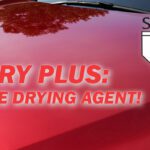Knowing the strength of the chemicals applied to vehicles is imperative to ensuring your wash produces outstanding results. The technique chemists use to determine the strength of a chemical is called titration, and they use special equipment to complete this process. Titration equipment for car washes can be purchased in kits, so you can get everything you need to test your chemicals with one purchase. In this article, we will guide you on how to use a titration kit correctly.
Important Terms
Before we cover anything else, we need to go over a few basic terms.
- Analyte: The substance of which the concentration is being determined.
- Titrant: This is the substance used to determine the concentration of the analyte.
- Indicator: Changes color once a neutral pH is reached. It signals the endpoint of the titration. At this point, the analyte is neutralized.
- Endpoint: The point at which the solution changes color and the pH is neutralized. Look for the first indication of a color change. The new color should be pale.
Titration Types
Now that you know these basic terms, we can talk about the types of titrations. Before conducting a titration, you must know the pH of the analyte (the chemical you are testing). Is it an acid or a base? This will determine the titrant and indicator you need to use when testing. See Figure 1 to help you choose the right combination of products. Kits will include the correct products for the titration they are created to perform.
| Figure 1: Choosing the Correct Titrant, and Indicator | ||
| Analyte | Titrant | Indicator |
| Acid | Base | Phenolphthalein, methyl orange, methyl red |
| Base | Acid | Methyl red, bromocresol green |
There are three common titration tests used in the car wash industry.
- Low pH Test: Determines the strength of acidic chemicals.
- High pH Test: Determines the strength of alkaline (base) chemicals.
- Water Hardness: Tests for the presence of calcium and magnesium.
How to Use a Titration Kit
When you purchase a kit, it will include instructions and a testing results sheet in addition to the equipment. Exact equipment and instructions will vary slightly depending on the kit you purchase.
Here are some basic instructions to give you an idea of how titration testing is generally conducted. These are general steps, so always defer to the exact instructions provided with your kit.
- Prepare the analyte by pouring some into a beaker or flask and recording the starting volume.
- Fill a graduated cylinder or burette (or other instrument that accurately measures liquid volume) with the titrant and record the starting volume.
- Add a few drops of indicator to the analyte solution.
- Slowly add drops of the titrant to the analyte solution and swirl until the endpoint is reached
- Record the final volume of the titrant in the burette.
- Count the number of drops it took you to reach the endpoint. Refer to the results testing sheet to find the dilution rate that corresponds to the number of drops used.
- For more accurate numbers you might want to compare the results of three tests and calculate the average.
Once you have conducted a titration, you will know the strength of the chemicals being applied to vehicles in your wash. There is one very important factor that will impact your results, and that is water hardness.
Hard Water Impacts Strength
Once you know how to use a titration kit, you need to understand the difference between a dilution ratio and titration. When the manufacturer provides a recommended dilution ratio, they assume your water is soft. Hard water will decrease the performance of the chemical at the recommended dilution ratio. A titration accounts for water hardness. For example, say the dilution ratio recommended by a manufacturer is 64:1. In soft water you might reach the endpoint of a titration in 10 drops, however, when performed in hard water it might take as many as 15-20 drops. Figure 2 shows you the performance impact of hard water on various types of car wash chemicals.
| Figure 2: Impact of Hard Water on Chemical Performance | |||
| Water Hardness in Grains Per Gallon (GPG) | Pre-Soaks | Tire and Wheel Cleaners | Drying Agents/Clear Coat Protectants |
| 0 – 2 GPG | 0% | 0% | 0% |
| 2 – 5 GPG | 15% | 15% | 5% |
| 5 – 10 GPG | 25% | 25% | 5% |
| 10 – 15 GPG | 35% | 35% | 10% |
| 15 – 20 GPG | 50% | 50% | 10% |
Purchasing a Titration Kit, What to Look For
When purchasing a titration kit there are a few things to consider.
Kit Type
The type of kit to use will be determined by the chemical you are testing. If you are working with an acid you will need a low-pH kit, and if you are working with a base (alkaline) you will need a high-pH kit. If you want to test for water hardness you will need a kit specifically designed for this purpose. Typically, kits will be labeled with their purpose and include all the products required to perform the titration. It is important to note that most kits are manufacturer-specific since each manufacturer uses different ingredients in their chemical blends. We recommend using a brand’s test kit ONLY with that same brand’s soap for the most accurate results.
Items Included
Typically, kits will include the following items.
- Graduated cylinder, burette, or other similar instrument to accurately measure the volume of liquids
- Pipette or dropper to draw and carefully add liquids to other containers in small amounts
- Beaker, flask, or other instrument to swirl the solution
- Indicator
- Titrant
Of course, you supply the analyte because it is the solution you are testing for strength. Various other tools and equipment can also be included. We carry a kit to cover all the titration types covered in this article, so you can get everything for you need in one place.
Now that you know how to conduct a proper titration, you can determine the strength of the chemicals used in your wash to ensure they are doing their job. Most importantly, you can make adjustments if they are not up to par so your customers get what they came to your wash for – a clean car!
This article originally appeared in Kleen-Scene 42 and was written by our Soap Specialist Steve Kelly.











